ShopDreamUp AI ArtDreamUp
Deviation Actions
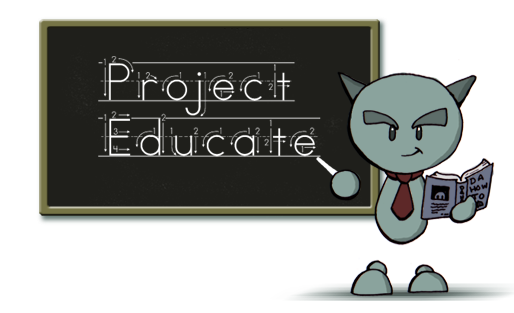
Printmaking produces images with visual qualities that are very different from those obtained through drawing or painting directly, and each technique adds its own peculiarities to the way each piece is conceived. Each of these techniques involves the use of a matrix or original surface which is manipulated in different ways, and from which multiple prints are produced. Each of these prints is an original, since they are not reproductions of another work of art.
However, with its odd and alchemical combinations of unusual materials, specific tools and enormous machines, Printmaking is often a strange and foreign territory even for artists accustomed to studio work on other disciplines.
While there are a great many different techniques, some of them done in ways dictated by ancient tradition and others spawned from modern technologies, it all comes down to four main categories:
Relief, Intaglio, Planographic and Screen Printing. These basic categories containing within themselves every specific category currently used by deviantART, and other important techniques not considered there, but also used by many deviants.
In this series, each of these main categories will be broken down so everyone can fully understand and appreciate the process involved in the making of the images you see in the Printing Gallery.
Relief
: Including Linocuts, Woodcuts and sometimes CollographsIn Relief printing, the areas of the matrix that are to show printed black are on the original surface; the parts of the matrix that are to be blank (white) are physically removed from the block with carving tools. It is the raised surface of the matrix that carries the image, and it is printed by applying ink to the surface with a hand roller (brayer). As the roller passes over the surface, it only reaches the raised areas of the matrix: everything remaining of the original surface pick up ink, leaving the removed, recessed markings clean.
 The image shows a carved block of MDF board and the tools that were used: a gouge with a V-shaped blade which allows for thin or thick lines depending on the depth of the cut, and an X-acto-type knife used for carving delicate details. The block is placed over a bench hook: a piece of board with one end sticking up and other down, the top one keeps the matrix from being moved by the action of the tools and the bottom one hooks the whole contraption to the edge of the table/bench.
The image shows a carved block of MDF board and the tools that were used: a gouge with a V-shaped blade which allows for thin or thick lines depending on the depth of the cut, and an X-acto-type knife used for carving delicate details. The block is placed over a bench hook: a piece of board with one end sticking up and other down, the top one keeps the matrix from being moved by the action of the tools and the bottom one hooks the whole contraption to the edge of the table/bench.To obtain the image, the block is put into a special press. Paper is laid on the block and pressure is applied by the press, transferring the ink from the block to the paper. Relief prints can also be obtained by "hand rubbing", placing the paper over the inked block and rubbing the back with what looks like a wooden Japanese rice spoon or a special tool called a baren. This avoids the use of a press and makes it possible to create Relief prints in an easy, affordable fashion.
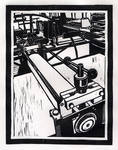 This is a linocut by OptimalProtocol, depicting a typical printing press used for many printmaking techniques. The block and paper are placed on a plate that passes between two cylinders (top cylinder and plate are shown on the print). Remember that every white space shown in the print had to be carved out of the original surface of the block!
This is a linocut by OptimalProtocol, depicting a typical printing press used for many printmaking techniques. The block and paper are placed on a plate that passes between two cylinders (top cylinder and plate are shown on the print). Remember that every white space shown in the print had to be carved out of the original surface of the block!Relief prints are often recognizable by what is called "impression". This refers to the indention caused by the relief pressing into the paper, and is one of its unique characteristics.
There are some peculiarities to making a Relief Print: First of all, you have to get used to the concept that you'll be working in negative, that is, that every mark you make with your tools on the matrix will produce a white mark on the final print. Second, that the final image will be a mirror image of what you have in the matrix, because the matrix works much as a stamp. This means that the image is designed and composed with that in mind, and special care must be put when including numbers or letters... it is all too easy to get carried away and let that fact slip.
"Bad luck for a lucky rabbit", grungepuppy said. It is all too easy even for experienced printmakers, as you can see.
There are many different materials one can use to make a relief print. These matrices begin with a halved potato and end with polymer resin wood engraving substitutes, passing through various woods and man-made materials like linoleum. Each have their own graphic possibilities, ranging from extra-sharp linework to expressive mark-making. Relief prints range from the detailed, multicolored Japanese prints to the raw images of European Expressionists. Here is a small selection of Relief Prints from the Traditional Gallery.
:thumb20902222:
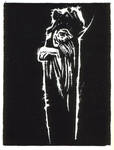


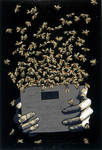



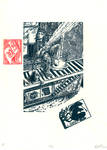 :thumb41969331:
:thumb41969331:

Mature Content

Mature Content










 :thumb51296769:
:thumb51296769:
 :thumb57651463: :thumb48568716:
:thumb57651463: :thumb48568716:


 :thumb41979907: :thumb51134957: :thumb51447160:
:thumb41979907: :thumb51134957: :thumb51447160:




 :thumb35062411: :thumb33138139:
:thumb35062411: :thumb33138139:

Next issue: Intaglio
november spawned a monster
it's that time of the year again. find me on facebook.
:thumb58779612:
well, i least i have each other...
wishlistcoughwishlist
i'm alive
+thanks to everyone who left messages expressing their concern for my family and I, it's been a terrible experience, since we live in Concepcion (Chile) and we were hit directly by the 8.8 quake. however, our apartment building handled it well, we weren't near the coast so were not threathened by the Tsunami and after a scary week we're finally together & safe. the beautiful old house where my tattoo shop was housed didn't resist the violence of the earthquake: the whole front of the second story crumbled and fell, and will surely have to be demolished. the old family which lived there and rented the space will lose their house and workplace
november spawned a monster
+it's that time of the year again, boys and girls...
"Poor twisted child
So ugly, so ugly
Poor twisted child
Oh hug me, oh hug me
One November
Spawned a monster
In the shape of this child
Who must remain
A hostage to kindness
And the wheels underneath her
A hostage to the kindness
And the wheels underneath her
A symbol of where mad, mad lovers
Must pause and draw the line."
i don't expect to be back here yet. got to get my head cleared still... i lurk and troll, though ;)
lustre prints and L devwear plz, you know, just in case you get the urge :)
<3
d.+
chop my hat in half and related
+ as you've noticed, i've resigned from the Community Relations Team. there were many reasons for this decision, and none of them involve dArama, so if that's what you were looking for, here's the door what's the hurry :P
basically, it's real life stuff. it wasn't an easy decision, i've been a Gallery Director/Moderator since 2007 and i enjoyed (almost) every day of it. i just kept thinking things would get better or easier and i'd be able to catch up on things and do what i feel a GM should be doing (and what the Traditional Community deserves) but it just isn't happening right now. other recent events mean i'll be moving out from this apar
© 2007 - 2024 stigmatattoo
Comments43
Join the community to add your comment. Already a deviant? Log In
Wow didn't realise you got articles like this on deviantart. Me likes!